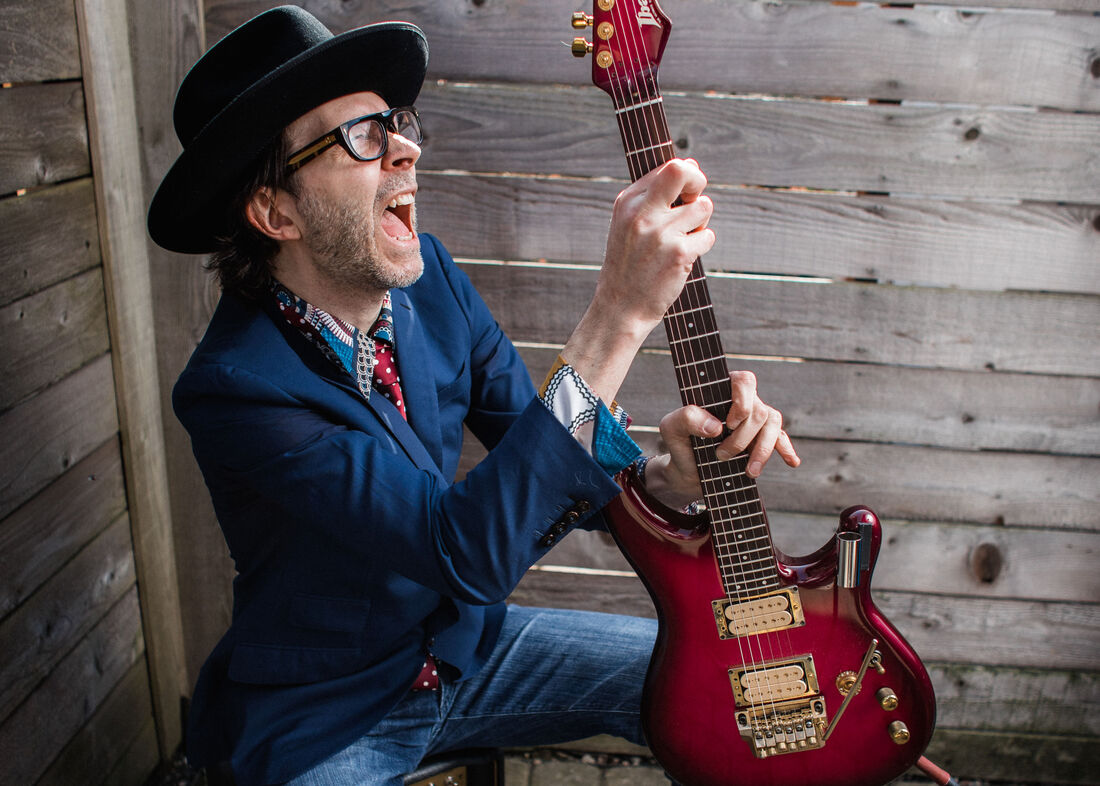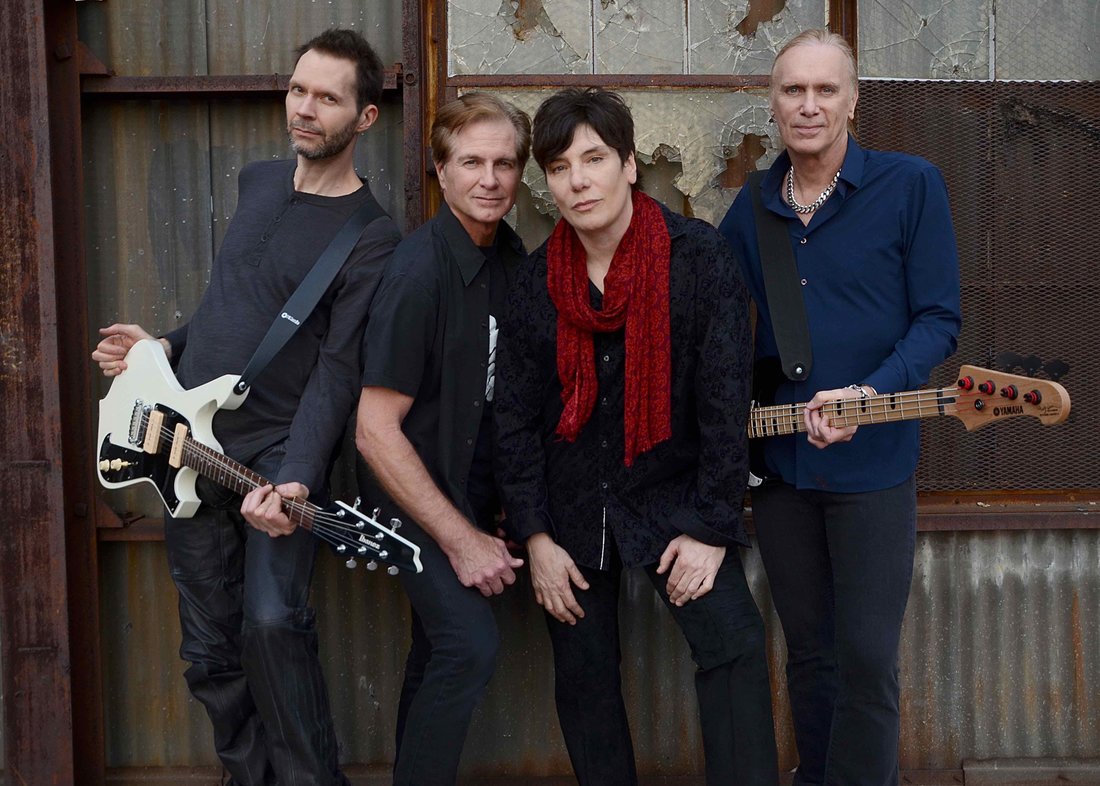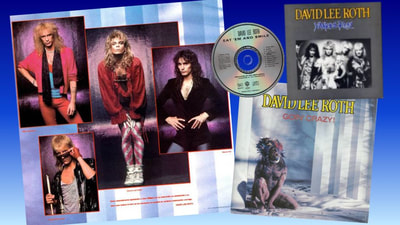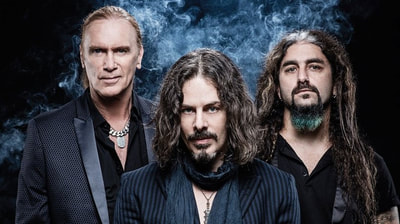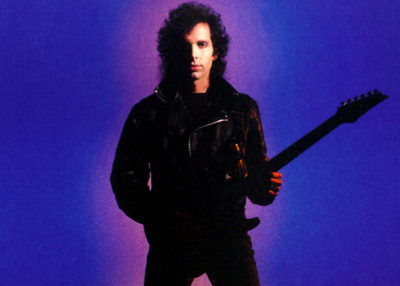|
A chat with Paul Gilbert is almost indecently entertaining. In fact, it’s less of an interview, and more a loose conversation peppered with tales, observations, and awesome guitar licks form a man who clearly knows his way around a fret board. At least that’s how it was when Paul sat down to chat to us about his new album ‘Werewolves of Portland’. Talking the new set, his guitar preferences through the years, and wowing us with random Judas Priest, Led Zeppelin, and Racer X riffs, we caught up with Paul via Zoom. Addicted to that rush; Eamon O’Neill.
[Paul Greets eonmusic with a screaming guitar lick]. That is a tasty tone, Paul; what are you using?!
It’s a Marshall. I can’t even remember the name of this amp; it’s just a small amp! [*laughing*] It’s a Marshall comb, and it has six knobs, and it sounds good. You’ve got to have it real clean and I just have a JHS PG14 overdrive [signature pedal], and an EarthQuaker Dispatch Master; which has both reverb and delay. That’s it! You’ve one of your current signature models on your knee, but you’re surrounded by guitars, as far as I can see! There’s some. I’ve got various things all over the place. It’s funny, the one that I’ve got right here [reaches behind to his guitar rack], this is a Hagstrom III, and I bought this because I was doing research about guitars with skinny necks, and you can really get your thumb over this. It’s the skinniest neck in the world. The reason I was doing that is, the more that I teach, the more I’m surprised at people’s instincts about how they hold their guitar. Holding the guitar was never something I thought about; I just sort of grabbed it, tried my best to play, and never thought about holding it one way or the other. But, from teaching, it’s really an issue, just how to hold it. So that led to your research? I’m a tall person with big hands, and so I can grab and my thumb can reach over – it’s not a big problem – but a lot of people with smaller hands, their hand won’t reach that way, especially on a wide neck. I had this one student at my school, and she was small, add she was young, and she’s Japanese, and she had the best musical instincts; just a perfect sense of time and pitch, and dynamics, and I could tell, really, in her soul was just this great musician, but she had small hands. And so, I wanted do find what instrument she could play, where she would be able to get her thumb over, and play proper rock – I don’t know if that’s an oxymoron ‘proper rock’! – but, to grab it like my heroes in the ‘70s; Hendrix and Brian May. Those are all ‘thumb-over’ guys, and so I bought that guitar because I was researching guitars with small necks, and I thought maybe she could play that. But she ended up getting an Ibanez endorsement, and they made her an instrument. I’m glad you mentioned Ibanez, because I wanted to rewind to NAMM Show 2020, when you appeared onstage with Steve Vai, Joe Satriani, and Nita Strauss, at the Ibanez event. Well, I think those NAMM Jam things have really improved over thee years. Here’s the thing; jamming with rock or metal can be a really difficult situation to be good because in general, metal players play loud rhythm, which fits the style. If you’re playing a Judas Priest song, when the solo comes up, the rhythm guitar player plays just as loud during the solo as they do during the rest of the song [starts playing Judas Priest’s ‘Heading Out to the Highway’]. It’s just non-stop, killing, loud, and you’re supposed to play the solo over that, and maybe the sound engineer is good, so they know to crank up the solo, but a lot of times in a jam where everybody’s playing together for the first time, it doesn’t work out very well because everybody’s just blasting away on the rhythm. That does sound like it has the potential to be a bit of a cacophony! I think over time people just figured out that when somebody’s playing, just shut up when you play the rhythm; either turn it off, or get quiet. The sound engineer is not the only person who is creating the mix; it’s up to the musicians too. When somebody else is playing, I just turn off. I just sit there and listen and dig it. I don’t need to be sitting there bashing out a G chord; the bass player’s doing that! We know it’s G! And everybody else does that too to a certain extent, so it’s a better environment now than it was in like 1987, or whenever I started going to NAMM Shows. We’re here to talk about ‘Werewolves of Portland’, and not only is it an incredibly a fun album, but it’s loaded with melody; how does it sound to your ears?
Well, the other thing I’d like to say is, I think the guitar play on the album is alright, but I really like the drummer. I was going to get to ‘the drummer’, but continue! [*laughing*]. Melody is a new thing for me believe it or not, and I think anybody who is not a guitar player, you’d think like; “oh, melody; isn’t that the first thing you do?”, and coming from my generation of guitar players, nobody did melody; that was the singer’s job. That’s the Shrapnel Records generation, you mean? Yeah, and so, to play melody and to actually want to play like that is really a new art, and a lot of things could go wrong! I remember, over the years I ‘d try playing ‘Black Dog’, the Led Zeppelin Song, and finally I’m getting to the point where I can feel like I’m connecting to it; [plays vocal melody “hey, hey mama said the way you move…” using slide]. My first couple of attempts, maybe twenty years ago, I’d be more square [plays the riff with practically no feeling], and it was horrible! You don’t need a slide, but you somehow need to slide into things, and in order to do that, you need to know what the right note is, but you also have to know the one that you’re going to hit below it, in order to slide up to the right one. So, you’re kind of aiming off-target all the time, and then you ease into the target, and that’s a lot of brainwork! Then you have to physically do it, you have to do it in time, and with dynamics; so playing melody to me, really, when you first get into it, it’s unbelievably complicated, compared to playing through a scale; hit the note, done! So that fed into the new album’s composition? I trained myself by learning vocal lines, especially with slide. I haven’t studied guitar players at all; I’ve studied singers. So like, ‘Mercedes Benz’, the Janis Joplin song [sings melody, then plays the chorus beautifully on slide guitar]; that’s like a new voice. It’s funny, the first time I heard a recording of myself playing slide recently, I was auditioning drummers in Portland, and we recorded it, and I was writing an email or something and I was listening to it, and when the slide came in, I was like; “who’s that other guitar player?!” It didn’t sound like me, in a really good way, like; “Who’s the guitar player?! I’m glad he’s playing, because I’m tired of hearing me!” Phrasing like that does bring more emotion into the playing. I still like the shredding stuff because that’s a real energy to it, but’s just nice to have these different colours to paint with. If it’s all one thing, it’s delicious at first, but it’s like food; if you only eat curry, man, it’s delicious, but after a while it’s like, “I’d really like to have some rice with this!” The album opens with ‘Hello North Dakota’, and that’s got to be a Brian May influence with those layered guitars. Well, Brian May is one of my favourites, and physically, I think we’re similar; the way he holds the guitar, and the way his hand is shaped around the neck. When I watch him play, it reminds me of me from a technical standpoint. And just from the way he plays, I’ve always love it. Of course, whenever you start stacking up harmonies, he was the guy that made that a famous sound. Compositionally, I got it from the state song of North Dakota [plays riff and sings “North Dakota!”], but the challenge wasn’t so much to play that, the challenge was to orchestrate it. How many guitar tracks did you use on that intro? It’s a five-part harmony. It’s funny, you know, coming from a heavy metal background, the first thing you think of is; “oh, of course, double it”, but my engineer, he said that; “you don’t have to; let’s do it once, and listen to it. I think it’ll be enough”, and it was. It was just one performance for every part of the harmony. I found a recording on YouTube of the ‘North Dakota’ theme song, and it wasn’t great fidelity, it was like a scratchy old recording from the fifties or forties, but compositionally, it was my favourite, and for some of it, I had to ask my wife; “what’s this note?”, because I don’t hear very well, and I’ve got a lot of treble missing from my hearing. But I was able to kind of orchestrate it out, and write all the notes down. It was funny because I hardly ever write anything down, and I’m a horrible sight reader. That was the challenge of that one; playing it, it’s not a fast, technical thing, but compositionally, you have to figure out those harmonies. You mentioned the drummer on the album, and as can be seen in the video for the title track, it’s you!
Well, I’ve been playing drums for a long time. Whenever I was in bands as a teenager, the drummer would go upstairs to have a beer, and I’d stay down in the rehearsal room and play his drums. He’d come back and I’d go; “can you show me that one thing? How do you do that phrase? How do you do that John Bonham lick?”. Man, I’ve played with some great drummers. I used to ask Pat Torpey [Mr Big] like; “Pat, can you show me that double stroke lick?!” Pat showed me how to play ‘Poor Tom’, that Led Zeppelin thing, and Pat showed me the shuffle in ‘Fool in the Rain’. So I got great lessons from Pat, great lessons from Jeff Martin – he’s the singer of Racer X, but a great drummer. For a long time I’d just set up a kit at home and play. I’ve got real basic technique; Pat may have showed me a double stroke, but that doesn’t mean I can do it! The title track reminds me of Rush in places, with its quirky timing; is it fair to say that Neil Peart is an influence? Yeah, I’ve done a lot of Neil Peart air drumming! I’d just stick on the headphones and play along with ‘Signals’ for hours upon hours! As a teenager, before I went to bed I’d play ‘Signals’ and put on ‘Subdivisions’ and ‘The Analog Kid’, ‘Chemistry’, and all those tunes on that record. I also love Vinnie Appice from Dio and Black Sabbath, and the drummer from Accept, Stefan Kauffman; his drumming on ‘Restless and Wild’, there’s all these little fills that I picked up, and I’d spend as much time on those as I would with guitar parts because it’s so cool! And Munetaka Higuchi from Loudness, man, he’s unbelievable! Of course there’s Bonham, Ian Paice, Mitch Mitchell; I couldn’t always do all of it, but I’d be aware of it, and I’d spend time with it at home. You are however, a guitar player first and foremost, and I love to ask players about their guitar collections; do you have a lot of your instruments from right across your career? Ah, let’s see! I do still hang on to some of the old favourites. Some of them I’ve given away to friends or contests, but the old ones, some of them I have, some of them I don’t. I’ve really gravitated towards the thicker necks. I’m a big fan of Pat Travers, and Pat was famous for playing a Gibson Melody Maker, and it was modified and had humbuckers and a badass bridge. Being a fan of his, I thought; “man, I’ve got to get one and check it out!”, so I bought one and had it modified like Pat’s, and it had the ‘baseball bat’ neck on it, and I really liked it. So when I had the first Fireman [signature guitar] made by Ibanez, they said; “well, what kind of neck do you want on it?” And I said; “how about like that Melody Maker I’ve got?”, and so they made it. The Gibson scale is not as long as like a Strat, and they made it real thick, and man, I just loved it! I could get more sustain and just feel the note more, and so I really fell in love with that guitar. The Fireman has become your main instrument these days. The thick neck was a part of it, but also, it’s just a big piece of wood that balances well, and it’s got a big headstock, and those things really seem to contribute to having a nice tone and a lot of sustain. We’ve done a lot of different versions of that with different pickups and different finishes and pickguard shapes, so that’s really become my favourite. It’s nice to have a guitar that, if I just go to a store and pick one up, it just feels like my guitar. Going back, you’ve also had your signature Ibanez PGM model. The older ones, the PGMs, are essentially like an RG with F holes on it, and those are interesting because certainly I spent a lot of time with those, and a big part of my career was playing those, There’s certain things that are easier; the strings are further apart in both directions; it’s a wider neck, and then also there’s a longer scale, so you just have more room on it. And there’s some nice things about that; I tend to play a little cleaner, because you’re less likely to bump into the next string. The sustain doesn’t match though, because it’s a much thinner neck, and so to me, it’s more of a shred guitar. If you want to play real clean or real fast, it’s nice for that. Did you use any other guitars on the album? One of the guitars I used on this album, I bought an old Epiphone and that’s what I used to use in the really early days of Race X. I had this Epiphone Olympic, and I bought it last year on Reverb. I had the Di’Marzio PG-13’s put in it and a slide magnet It’s got a small neck but it is a little bit chunky, so it’s got sustain, but the strings are close together. Everything is easy on that one! Before we wrap up, I wanted to ask about future activity from Mr Big; will there be a final album or tour?
Well, I hadn’t thought about it until I started doing interviews and everybody asked me about it. But what I was doing with Mr Big, really, my main artistic project if I get time to tinker and like, self-improve, is to learn vocal melodies, and I love Eric [Martin]’s vocal melodies. So I’ll sit around and learn like; [plays impassioned verse and chorus melody lines to ‘To Be With You’ on slide guitar]. When I first tried to do that it was almost impossible, but I’ve learned so much from doing that. What’s happening is, at the moment I’m more comfortable in the role of a lead vocalist. That’s more enjoyable to me, to actually be the singer. It’s not the first time you’ve incorporated vocal melodies in to your solos; ‘To Be With You’ from 1991 is a perfect example of that, albeit with some slinky licks thrown in too! [plays final lick of solo] That last part [plays the final two notes]; I totally got that from a song called ‘Down By The Seaside’ by Led Zeppelin [plays the riff before the ‘people turned away’ refrain]. I’ve got to thank Jimmy Page for that one! Finally, what’s next for Paul Gilbert? At the moment I’m starting to prepare for ‘The Great Guitar Escape’, which is a camp that I’ve done a few times. I’ve got my shots, and so has everybody else, and we’re going to see if we can really do it. That’ll be a big thing, the first time doing something out of the house. This whole time the thing that’s kind of kept me sane besides doing the record is my online guitar school and artist works. I’ve done over 11,000 video exchanges there with my students. And I’ve got the seeds of a new album that I’m planning. It’s at the very beginning of planning, but that’s a secret until I’ve got it going. Paul Gilbert's 'Werewolves of Portland' is out now, via Mascot Group. Listen via Spotify, below. |
|
Paul Gilbert.
"Melody is a new thing for me, believe it or not. Coming from my generation of guitar players, that was the singer’s job."
© 2016 - 2024 eonmusic.co.ukContact: [email protected]
|

